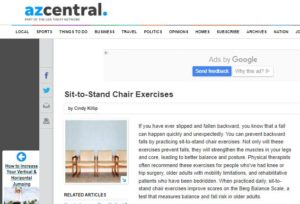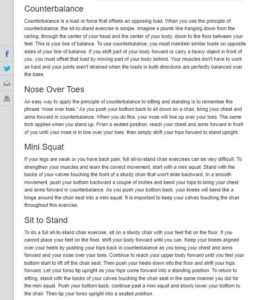
If you have ever slipped and fallen backward, you know that a fall can happen quickly and unexpectedly. You can prevent backward falls by practicing sit-to-stand chair exercises. Not only will these exercises prevent falls, they will strengthen the muscles in your legs and core, leading to better balance and posture. Physical therapists often recommend these exercises for people who’ve had knee or hip surgery, older adults with mobility limitations, and rehabilitative patients who have been bedridden. When practiced daily, sit-to-stand chair exercises improve scores on the Berg Balance Scale, a test that measures balance and fall risk in older adults.
Counterbalance
Counterbalance is a load or force that offsets an opposing load. When you use the principle of counterbalance, the sit-to-stand exercise is simple. Imagine a plumb line hanging down from the ceiling, through the center of your head and the center of your body, down to the floor between your feet. This is your line of balance. To use counterbalance, you must maintain similar loads on opposite sides of your line of balance. If you shift part of your body forward or carry a heavy object in front of you, you must offset that load by moving part of your body behind. Your muscles don’t have to work as hard and your joints aren’t strained when the loads in both directions are perfectly balanced over the base.
Nose Over Toes
An easy way to apply the principle of counterbalance to sitting and standing is to remember the phrase “nose over toes.” As you push your bottom back to sit down on a chair, bring your chest and arms forward in counterbalance. When you do this, your nose will line up over your toes. The same trick applies when you stand up. From a seated position, reach your chest and arms forward in front of you until your nose is in line over your toes, then simply shift your hips forward to stand upright.
Mini Squat
If your legs are weak or you have back pain, full sit-to-stand chair exercises can be very difficult. To strengthen your muscles and learn the correct movement, start with a mini squat. Stand with the backs of your calves touching the front of a sturdy chair that won’t slide backward. In a smooth movement, push your bottom backward a couple of inches and bend your hips to bring your chest and arms forward in counterbalance. As you push your bottom back, your knees will bend like a hinge around the chair seat into a mini squat. It is important to keep your calves touching the chair throughout this exercise.
Sit to Stand
To do a full sit-to-stand chair exercise, sit on a sturdy chair with your feet flat on the floor. If you cannot place your feet on the floor, shift your body forward until you can. Keep your knees aligned over your heels by pushing your hips back in counterbalance as you bring your chest and arms forward and your nose over your toes. Continue to reach your upper body forward until you feel your bottom start to lift off the chair seat. Then push your heels down into the floor and shift your hips forward. Let your torso tip upright as your hips come forward into a standing position. To return to sitting, stand with the backs of your calves touching the chair seat in the same manner you did for the mini squat. Push your bottom back, continue past a mini squat and slowly lower your bottom to the chair. Then tip your torso upright into a seated position.
References
- American Council on Exercise: Bodyweight Squat
- MayoClinic.com: Squat Exercise
- National Institutes of Health: Exercise & Physical Activity: Your Everyday Guide from the National Institute on Aging
- Age and Ageing: Sit-to-Stand as Home Exercise for Mobility-Limited Adults Over 80 Years of Age
- Journal of the American Physical Therapy Association: Clinical Measurement of Sit-to-Stand Performance in People With Balance Disorders: Validity of Data for the Five-Times-Sit-to-Stand Test
About the Author
Cindy Killip is a medical exercise specialist, health coach, author and speaker who has been teaching and writing about exercise and wellness since 1989. She authored the book Living the BONES Lifestyle: A Practical Guide to Conquering the Fear of Osteoporosis [2012]. Killip holds multiple certifications through the American Council on Exercise and degrees in communications and sociology from Trinity University with a focus on pre-med and exercise science. She studied exercise physiology as a graduate student at the University of New Mexico.


Full article on azCentral: http://healthyliving.azcentral.com/sittostand-chair-exercises-14984.html




